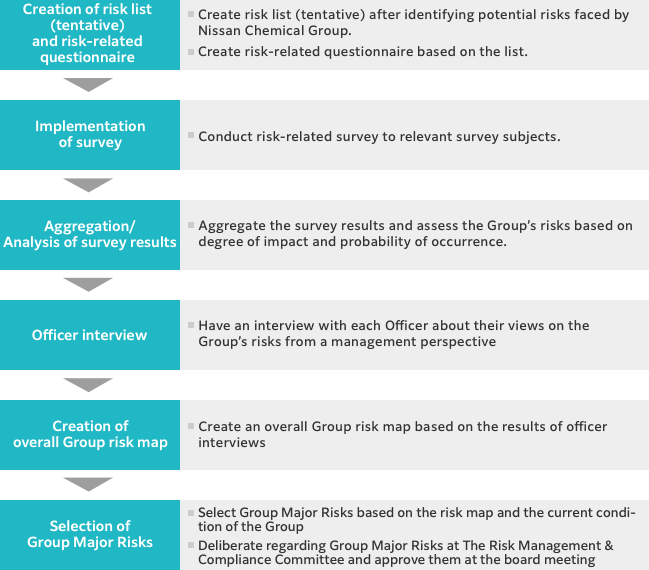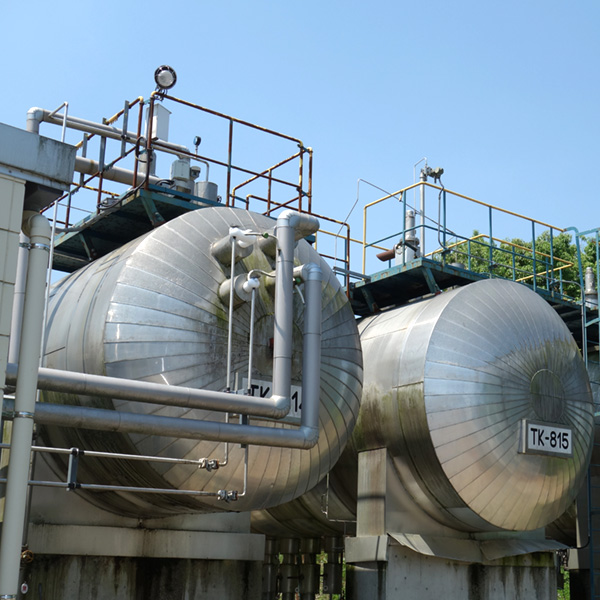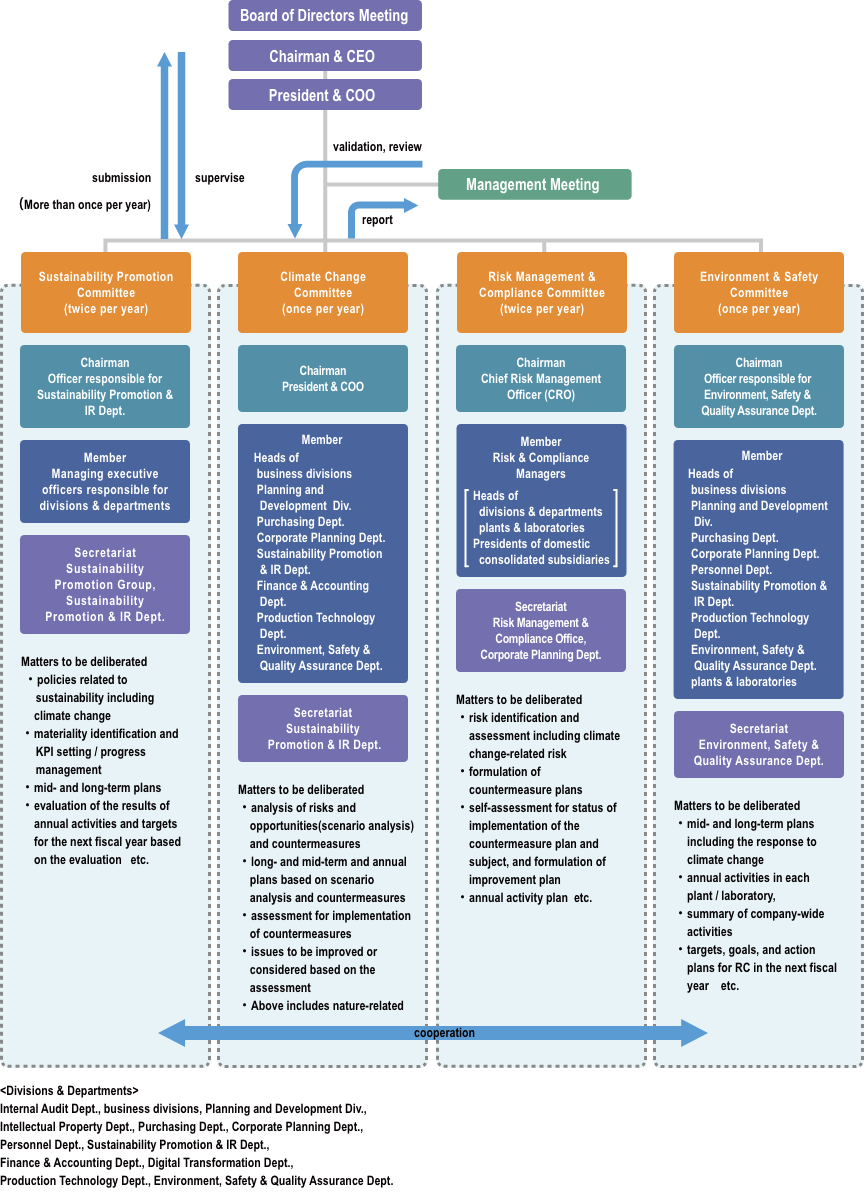
Sustainability
Sustainability
- HOME >
- Sustainability >
- Sustainability >
- Information Disclosure in Line with TCFD and TNFD Recommendations
Information Disclosure in Line with TCFD and TNFD Recommendations
Support for TCFD and TNFD
Due to the consumption of large amounts of fossil fuels, like petroleum and coal, since the Industrial Revolution, emissions of carbon dioxide and other greenhouse gases (GHGs) are increasing and aggravating global warming. There are growing concerns that climate change, associated with global warming, will impose widespread negative effects on people’s lives and the ecosystem, as exemplified by an increase in heavy rains, floods, and other natural disasters, a decline in food and water resources, and extremely hot weather caused by heat wave, and outbreaks of infectious diseases.
The Paris Agreement, which went into effect in 2016, sets its long-term global goal of keeping the rise in average temperature well below 2°C (2°C target) and states that preferably the limit of the increase should only be 1.5°C to slow climate change and make a transition to a decarbonized society.
We, Nissan Chemical Corporation, endorse the Paris Agreement and position “climate change mitigation” as one of the Materiality elements, thereby having set our mid-term target (Scope1 + 2) of “reducing GHG emissions by at least 30% from the FY2018 level by FY2027” aiming for the achievement of carbon neutrality in 2050. We also support the Japanese government’s initiatives to curb global warming and comply with the Act on Promotion of Global Warming Countermeasures and the Act on the Rational Use of Energy.
In addition to climate change, natural capital-related issues, such as the shortage and dwindling of natural resources, biodiversity loss, and ecological collapse, have recently become our most serious concerns. Without the existence of various living things that interact in the ecosystem on the earth, the health and stability of natural capital cannot be maintained, and our human society and economy also cannot be established. Therefore, natural capital and biodiversity have become recognized as material risks worldwide.
In December 2022, the Kunming-Montreal Global Biodiversity Framework was adopted by the Conference of the Parties to the Convention on Biological Diversity of the UN. The Framework set its global 2050 vision, “a world of living in harmony with nature by 2050,” and its 2030 mission to “halt and reverse biodiversity loss to put nature on a path to recovery or be ‘nature positive.”
To contribute to a world of “nature positive,” we started enhancing our biodiversity initiatives, specifically assessing our businesses’ dependencies and impacts on the environment and nature-related risks and opportunities brought on us.
In that context, we supported the recommendations of the Task Force on Climate-related Financial Disclosures (TCFD) in August 2020, became a member of the Task Force on Nature-related Financial Disclosures (TNFD) in April 2023, and were registered as a TNFD Adopter in 2024. The TCFD/TNFD recommendations define 4 items that are recommended for disclosure: “Governance,” “Strategy,” “Risk Management,” and “Metrics and Targets.” We will ensure transparency of information by disclosing our climate change-related and nature-related information to all stakeholders, including investors, and by promoting dialogue. Also, to further contribute to realizing a sustainable society, we strive to deepen exchanges of opinions with our stakeholders, enhance our climate-change and biodiversity-related efforts, and improve disclosure.


Governance
The Group’s corporate philosophy underlying our business is “Contribute to the protection of the global environment and the existence/development of humanity, offering the value sought by society.” We recognize that practicing this philosophy will lead to the sustainability of society and the Company as the foundation of all our activities.
Our initiatives to address climate change are examined and deliberated at the Sustainability Promotion Committee, Climate Change Committee, Risk Management & Compliance Committee, and Environment & Safety Committee. The Board of Directors supervises those efforts by discussing and approving the Committee’s deliberations at its meetings. Since natural capital, including biodiversity, is significantly related to climate change, it is the subject of examination and deliberation by the Climate Change Committee.
As one of our initiatives for nature-related stakeholder engagements, we have the Nissan Chemical Group Human Rights Policy, which covers all our stakeholders’ human rights. Based on the Policy, we conduct a risk assessment (due diligence) concerning stakeholders, which contains nature-related metrics, such as health, safety, and use of natural resources (including water). As the “health and safety of local communities” is our priority, we especially enhance countermeasures. Specifically, we constantly hold plant tours and briefings for residents and neighboring schools to encourage their understanding of the safety and secureness of our plants and two-way communication with them.
Please see the following pages for stakeholder human rights responses and interactions with local communities.
- Respect for Human Rights:https://www.nissanchem.co.jp/eng/csr_info/management/hrp.html
- Contribution to Communities and Society:https://www.nissanchem.co.jp/eng/csr_info/communication/community.html
Sustainability Promotion Committee
To strategically tackle global social issues such as climate change, we have the Sustainability Promotion Committee as a body to consider and deliberate material matters under the Board of Directors.
The Executive Officer in charge of the Sustainability Promotion & IR Department chairs the Committee, composed of other Executive Officers who are responsible for and supervising Business Divisions and production technology. The Committee has a meeting twice a year on a regular basis to deliberate policies related to climate change and sustainability issues, the Materiality identification, KPI setting/progress management, mid-and long-term plans, and evaluation of an annual activity report and targets set for the next fiscal year based on the result.
At least once a year, the reasonableness of the Committee’s deliberations is evaluated and reviewed at the Management Meeting. After approval by the Management Meeting, the following matters are submitted to the Board of Directors.
- Policy planning related to sustainability
- Long- and mid-term and yearly plans for sustainability
Climate Change Committee
We have the Climate Change Committee as an independent body under the Board of Directors to accurately grasp the risks and opportunities posed by the increasingly serious climate change problem, integrate them into our management strategies, and strengthen comprehensive climate change countermeasures. The Committee, chaired by the Director and President, comprises the following respective division/department heads: each Business Divisions, the Planning and Development Division, the Purchasing Department, the Corporate Planning Department, the Sustainability Promotion & IR Department, the Finance & Accounting Department, the Production Technology Department, and the Environment, Safety & Quality Assurance Department. The Committee also comprehensively addresses natural capital as it correlates tightly with climate change.
In addition to a regular meeting once a year, this Committee meets as needed to analyze risks and opportunities related to climate change and natural capital, to consider policies, goals/targets, and plans. After approval by the Management Meeting, the following matters are submitted to the Board of Directors.
- Scenario analysis and countermeasures for climate change and natural capital
- Long- and mid-term and yearly plans for climate change and natural capital-related measures
Risk Management & Compliance Committee
We have the Risk Management & Compliance Committee as a body to enhance the effectiveness of risk management and maintain and promote compliance. Its regular meeting is held twice a year.
The Committee is chaired by the Chief Risk Management Officer (CRO) appointed by the Board of Directors. As its members, the CRO appoints the respective Risk & Compliance Managers of the divisions/departments, plants/laboratories, and domestic consolidated subsidiaries.
The Risk & Compliance Managers periodically identify and assess risks including those related to climate change and natural capital, draw up a countermeasure plan, self-assess the status of implementing those measures and issues to address, and suggest an improvement. In addition, they offer education and training at each division/department, plant/laboratory, and the domestic consolidated subsidiary about risk management and compliance. The Committee deliberates on those risk management initiatives and creates an activity plan for the next fiscal year. At least once a year, the reasonableness of the Committee’s deliberations is evaluated and reviewed at the Management Meeting. After approval by the Management Meeting, the following matters are submitted to the Board of Directors.
- Identification of the Group’s major risks (“Group Major Risks”) and countermeasures against them
- Mid-term and yearly plans for risk and compliance
Environment & Safety Committee
Responsible Care (RC) activities are voluntary initiatives undertaken by business operators in the chemical industry, aiming to ensure environment, health, and safety (EHS) throughout the whole process, from developing chemical products through manufacturing, distribution, use, final consumption, disposal, and recycling. Those initiatives include having dialogue and communication with society by announcing the outcomes of those efforts. As a body to promote RC activities, we have the Environment & Safety Committee, chaired by the Executive Officer responsible for the Environment, Safety & Quality Assurance Department, and its regular meeting is held once a year.
The committee discusses the results of RC activities in each site for the fiscal year, a summary of company-wide activities, and objectives, targets, and action plans for RC in the next fiscal year. The committee also shares information with the Sustainability Promotion Committee and discusses plans, including responses to climate change and environmental impact reduction.
At least once a year, the reasonableness of the Committee’s deliberations is evaluated and reviewed at the Management Meeting. After approval by the Management Meeting, the following matters are submitted to the Board of Directors.
- Draft of RC-related policy
- Long- and mid-term and yearly plans for RC
【Supervision and Execution System】
Risk Management
Process to Select Group Major Risks
Taking into account the business characteristics of each division and global political, economic, and social circumstances surrounding the business, we identify risks—including those related to climate change and natural capital—within the framework of the Risk and Compliance Committee. Next, we conducted a risk assessment based on the probability of each risk and its impact on our business activities. Given the assessment result, we created a risk map and selected the Group Major Risks. The risk map and the Group Major Risks were deliberated at the Risk Management & Compliance Committee and approved by the Board of Directors.

Management Process of Group Major Risks
A division/department in charge and a risk owner are designated for each Group Major Risks selected. The Risk & Compliance Managers of the divisions/departments in charge of those Major Risks have a central role in drawing up the Group Major Risks countermeasure plan, which is deliberated at the Risk Management & Compliance Committee and approved by the Board of Directors. The implementation status of countermeasures is also deliberated at the Risk Management & Compliance Committee, and the deliberation is reported to the Board of Directors.
Regarding typhoons and torrential rain, one of the Group Major Risks, we set the KPI of “Update and maintain BCP for products that account for 50% of ordinary income by FY2027” as a measure to mitigate risks of increased equipment restoration costs and the reduction of production at major plants. We have completed the update and maintenance of BCP for products consisting of 81% of ordinary profits as of the end of FY2024.
In addition, we regularly clarify risks, assess their impact on our business and their probability, and review the Group Major Risks.
Please see the following web pages for the risk map, the Group’s Major Risks, and countermeasures against risks.






